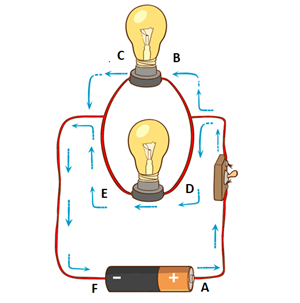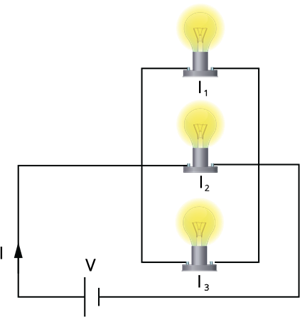PDF chapter test TRY NOW
In a parallel circuit, more than one resistors are arranged on many paths. This means charges (electrons) can travel from one end of the cell through many parts to the other end of the cell. Here, voltage across the resistors remains the same, but the current flowing through the circuit gets divided across each resistor.

Parallel circuit
In the above diagram, current can pass in two paths:
- \(ABEFA\)
- \(ADEFA\)
Here, it is clear that the cell's electricity can pass through either route \(ABEFA\) or route \(ABCDEFA\) to return to the cell. In parallel circuits, when one resistor is removed, the others will work because the electricity does not flow through only one path.

The above image shows a parallel connection in a house. If any one bulb fails to work, the others will work without any defect.
All the electric bulbs in our homes are connected in a parallel circuit. Even if one bulb burns out, the other bulbs in the same rooms will still work. The bulbs in a parallel circuit do not get dim as in series circuits. This is because the voltage across all the branches is the same in parallel circuits.

\(3\) bulbs in parallel
Let us consider three bulbs connected in parallel. Let be the voltage across the bulbs and , , be the current across each electric bulb. The current from the battery is the total of the individual current flowing through the resistances.
The total current in the circuit is given by,
Reference:
https://commons.wikimedia.org/wiki/File:Badshahi_Bungalow_Inside_View_001.jpg
